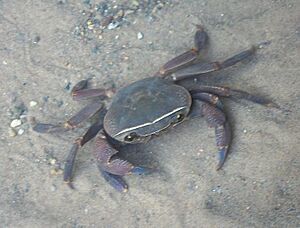Potamonautes sidneyi facts for kids
Quick facts for kids Potamonautes sidneyi |
|
|---|---|
 |
|
| Conservation status | |
| Scientific classification | |
| Synonyms | |
|
Potamon sidneyi Rathbun, 1904 |
Meet the Natal river crab, also known as Potamonautes sidneyi! This cool creature is a type of freshwater crab from the family Potamonautidae. You might also hear people call them "river crabs" or "land crabs" because they live near water but also spend time on land.
Where They Live
The Natal river crab lives in many places! You can find them all over KwaZulu-Natal, South Africa. They live from the tall Drakensberg mountains down to the coast, from Port Shepstone up to Lake Sibayi.
These crabs are also found in other parts of South Africa. This includes the provinces of the Northern Cape, Mpumalanga, North West, Gauteng, Free State, and the Eastern Cape. Beyond South Africa, they also live in the countries of Eswatini and Mozambique.
How They Behave
Natal river crabs like to hide in burrows. They dig these homes into the muddy sides of river banks. Sometimes, they hide under rocks in rivers.
They usually come out of their shelters at night. They also appear after it rains.
Life Cycle and Reproduction
These crabs mate outside of the water. After mating, the female crab carries her eggs. She keeps them safe under her wide tail. She carries them until they grow into tiny, fully formed crabs.
When the young crabs are ready, she releases them. She lets them go into calm, quiet pools in streams. The young crabs spend a lot of their early life in the water. They hide under leaves, stones, and among tree roots that reach into the water. As they get older, they start to spend more time on land.
Their Role in Nature
River crabs are very important for their ecosystem. They help move energy around the environment. They are important detritivores, which means they eat dead plants and animals.
By eating organic debris, they break it into smaller pieces. This makes food available for other river animals. It also helps recycle nutrients in the river.
These crabs are a main food source for some animals. Cape clawless otters and water mongoose love to eat them. Nile monitors might also eat these crabs.


